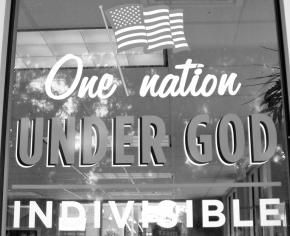Is America a right-wing country?
Republicans may be poised to win in the November elections, but that doesn't mean a majority of ordinary Americans accept the right's ideology and program as their own.
IN A number of recent interviews, leading left intellectual Noam Chomsky has compared the atmosphere in the U.S. today to that of the Weimar Republic in Germany before Adolf Hitler took power. Chomsky compared the base of the so-called Tea Party movement to the base of the Nazi Party, and many on the left likewise see in the Tea Partiers an incipient American fascism.
What exactly is motivating people to make these sorts of comparisons? With the midterm election campaign heating up, one obvious factor is the polling evidence over almost a year showing that the Republicans are positioned to make major gains in November. More startling signs come from a number of events that seemed to indicate a real shift rightward among sections of the population: from Tea Party protests to public support for rounding up immigrants or denying Muslims places to worship.
But what makes people move from observations about support for conservatives to worries about incipient fascism is the notion that "it wasn't supposed to be like this."
Only a year or so after the biggest economic crisis since the Great Depression punctured all the neoliberal and conservative myths about the free market and gave a Democratic administration the opportunity to change course, it seems that not much has changed.
Instead of a movement calling for the bankers and CEOs to pay for the crisis they caused, we seem to have a "movement" in the Tea Party calling for a deepening of "free market" policies that will only make these matters worse. This leads many people to conclude that there is something fundamentally wrong not just with American politics, but with the American population itself.
Admittedly, this is something of a one-sided portrayal of the fears about right-wing America. But it fits a picture of ordinary Americans that many liberals and progressives hold.
MOST OF the explanations for this situation tend to explain support for the right as a bottom-up affair--a shift in cultural attitudes in reaction to the 1960s or a "false consciousness" that prioritizes social issues like abortion above economic issues like job security.
While these explanations reflect a certain reality, they don't explain it. It is better to look at the overall political climate that shaped these perceptions.
Following the Second World War, a postwar economic boom seemed to guarantee steadily rising living standards and social spending, no matter which party occupied the White House. But when the postwar boom came to an end in the mid-1970s, the corporate class collectively launched an aggressive employers' offensive aimed at breaking the power of major industrial unions, rolling back the social gains of the 1960s and challenging regulatory victories against business won by the likes of Ralph Nader and the environmental movement.
The clearest symbol of this offensive in the 1980s was the presidency of Ronald Reagan. But the employers' offensive didn't end with the Reagan administration. It continued through the 1990s and accelerated again after 2001.
The first decade of the 21st century has been one in which corporations rescinded longstanding pension and health care benefits won in union contracts decades earlier, while workers faced falling household incomes. And the effort to restrict or eliminate welfare-state protections--an important part of the business mobilization against the working class from its beginnings 30 years ago--has also continued.
Reducing the "social wage" required an assault on liberalism, the main ideological prop to the postwar welfare state. Big business spent millions to create an infrastructure of think tanks, journals, legal foundations and other organizations dedicated to reviving the old "free-market" ideas of neoliberalism. This process is still going on today. Jane Mayer's recent New Yorker exposé documents how the right-wing billionaire Koch brothers have largely bankrolled the "grassroots" Tea Party movement.
The Republican Party rebuilt its mass component through an appeal to segments of the population that rejected the social changes of the 1960s.
The 1964 Barry Goldwater campaign, although ending up on the losing end of the biggest presidential landslide in U.S. history, road-tested a new approach that conservatives later perfected. Conservatives learned how to excite political passions--not with their traditional rhetoric about property rights, but when they talked about so-called "cultural" issues that appealed to large sections of the population, particularly white southerners moving away from the Democratic Party as the civil rights movement challenged the old order.
Thus, the conservative establishment was able to pull off something that had eluded it in the past--a fusion between traditional conservatives worried about holding back social change and business conservatives more interested in the bottom line.
It wasn't simply that conservatives learned to appeal to two different groups. They made "big government" the enemy. The business conservatives could oppose "big government" for reasons of taxes and regulations, while traditionalists could cast themselves as opponents of a political system that was seen as siding with Blacks, women, welfare recipients and so on, against them.
OVER MORE than three decades, the forces of official conservatism--from the Christian Coalition to the Republican Party--developed an anti-liberal politics that managed to gain a foothold with at least a pretty consistent one-third of the American population.
Conservative government policies like increased Pentagon spending or government aid to "faith-based" organizations nurture these constituencies. The right-wing noise machine--including talk radio and Fox News, whose emergence flows from the Reagan administration's decision to end the "fairness doctine" in the media--serves up the conservative agenda with a daily dose of right-wing propaganda.
These factors, developed over close to half a century in all, helped create "Red State America." One election was never going to undo them.
Moreover, the successful enactment of the neoliberal program of tax cuts for the rich, cuts in social spending and attacks on trade unions has undermined the foundations of the liberal state--which weren't that strong to begin with in the U.S.
For example, the corporate gutting of pensions and their shift into market-based 401(k) programs means that a politics of resentment can take root among those who have been devastated in the financial crash. People who lost thousands in their 401(k)s can be susceptible to arguments--which the right will furnish without hesitation--about "greedy" public-sector workers who still have pensions. A generation ago--before the dismantling of the pension system--it wouldn't have been as easy to sow these divisions.
The weakening of trade unions has meant the disappearance of even a minimal presence of labor's voice in the political arena. So while business-bankrolled conservatives can vent their "populist rage" 24-7 on Fox News and talk radio, voices of labor, organized or otherwise, are barely heard above the racket.
And this isn't even to mention the fact that labor's chosen political party, the Democrats, considers appeals to "class warfare" the equivalent of drinking poison. For much of Obama's term, leading liberal organizations have played "good soldiers" in trying to carry out the White House's agenda. As a result, there has been no sustained national effort to give voice to millions of people facing economic devastation today.
So when working people devastated by the economic crisis look for explanations for the conditions they face, they are more likely to hear the right's echo chamber blaming immigrants, Muslims or "big government" than a consistent case for solidarity against the banksters and corporate crooks.
We live today in a climate where both economic polarization between rich and poor and political polarization--the growth of far right and the potential growth of a radical left--can manifest themselves. Therefore, political issues can become sharply divided as politicians and activists seek more radical solutions to a status quo that is obviously not working.
Given this situation, the Obama administration has done itself no favors with its excessively cautious strategy of keeping to the political center.
The Democrats had large majorities in both houses of Congress, including, for a period of time, a 60-vote majority in the Senate that could overcome Republican filibusters. They had the potential to reset mainstream politics for a generation.
Yet with the Obama administration in the lead, the Democrats mainly assumed the role as chief administrator and defender of the financial system bailout passed in 2008. As John Judis explained in a recent New Republic article, "What doomed Obama politically was the way he dealt with the financial crisis in the first six months of his presidency. In an atmosphere primed for a populist backlash, he allowed the right wing to define the terms."
As a result, the odds are favorable that the Republicans can win one or both houses of Congress in the November election. Opinion polls are registering levels of anti-incumbent sentiment last seen in 2006 and 1994, two elections when the results led to congressional majorities switching to the other party. Currently, the Republicans hold a 5 to 6 percentage point edge on the Democrats in the "generic ballot" polls for Congress.
BUT THERE'S a difference between the Republicans electing more representatives and a majority of ordinary Americans accepting the right's ideology and program as their own. In fact, when you scratch below the surface, you find that consciousness on a whole range of issues is very mixed.
For example, if you look at the mere "horse-race" support/oppose polls on the health care reform law passed by Democrats earlier this year, you find that more people oppose health care reform than support it. But when you look below the surface of these polls, you find that about one in five people oppose the health care law because it doesn't go far enough in changing the system. These are people who think the Democrats should have fought for a single-payer program.
If you add together the people who support the health care law that passed with those who want genuine health care reform, the supposed conservative anti-reform majority becomes a minority.
Likewise, when you look at the question of immigration, you find a majority of people in favor of the racist SB 1070 law in Arizona. But a majority of people younger than 30 oppose the bill. And even a majority of those who say they support SB 1070 actually favor a "path to citizenship" for immigrants who have been living and working in this country for years, according to a recent America's Voice poll--the opposite of the right-wing position on immigration.
Again, you don't find a monolithic conservative population. Instead, you see a dysfunctional political system that can muster support for bashing immigrants and cutting "entitlements," but can't muster the political will to create a genuine national health care program.
As the November elections approach, the media and much of the left will be filled with commentary about how U.S. politics is returning to the right. We will hear all the old crap about how America remains a "center-right nation," how Americans can't overcome racism to support a Black president, how the Democrats overreached and the like.
But for millions of Americans, the last three years have altered their views of the world. They remain open to a critique of capitalism--and even to "socialism," as a recent Gallup Poll showed. Young workers facing declining economic prospects hold quite progressive views.
What's needed to transform these attitudes into action that can shift the political climate is organization to give voice to those more progressive impulses.
Even though the last year has seemed to be bleak, it's possible to show how mobilization can shift politics in a positive direction.
Consider the example of equal marriage rights for LGBT people. In the wake of the passage of California's anti-marriage referendum Proposition 8 in 2008, a mobilization for marriage equality emerged. This mobilization's high point was the October 2009 National Equality March, a grassroots-led rally of 200,000 in Washington.
A recent CNN poll found for the first time a 52-46 percent majority supporting the right of LGBT people to be married. Without a movement speaking out for equal marriage, it's unlikely that public opinion would shift so decisively.
As recently as 2004, political pundits were declaring that opposition to gay marriage was the magic wand that George W. Bush's advisers could wave to make the electorate forget his disastrous first term in office. Bush's re-election in 2004 prompted countless declarations that U.S. was an inalterably "center-right" nation. Yet only four years later, 69.5 million Americans voted for a man whose opponents accused him of being a secret socialist who "pall[ed] around with terrorists."
Whatever happens in November, working people will face a more concerted attack on their living standards and rights in the next year. We need to build the kind of organizations and struggles to meet that challenge.



